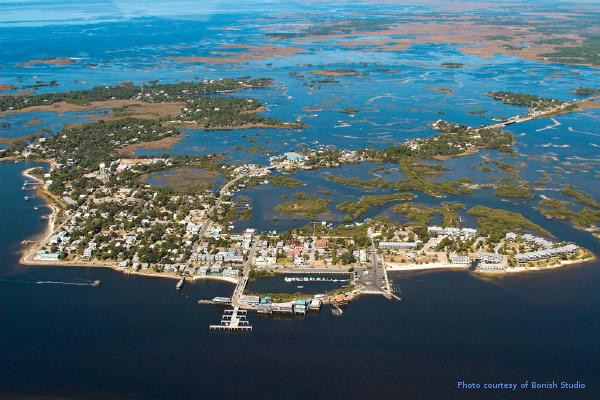Don't let the small population and area of Cedar Key fool you ... this is one of
the most vibrant and exciting places on the Nature Coast of Florida to visit.
Whether you like exploring the coastal waters by kayak or motorboat, discovering
Florida's early history, or eating in world-class seafood restaurants in an
active nightl-life district ... Cedar Key has it all.
The "Island City", as it likes to refer to itself, was first settled on
Atsena
Otie Key in the early 1840's. Originally known as "Depot Key", it once was home
to an army base used to coordinate Indian affairs. A post office was established
in 1845 and the City of Atsena Otie was chartered by the Florida legislature in
1859. The town became an important shipping port, and a lighthouse was built in
1854 on nearby
Seahorse Key. Florida's first railroad, completed in 1860,
connected Cedar Key to Fernandina on the east coast.

During the Civil War, Cedar Key was an important source of supplies, including
salt, to the Confederate Army. It was invaded by Union forces in 1862, and
occupied for the remainder of the war. The salt works were destroyed as part of
the invasion, but you can still see an original salt kettle at the
Cedar Key Museum State Park.
In the late 1800's, many residents of Atsena Otie had relocated to Way Key ...
the next island toward the mainland. The new town had been incorporated in 1869. A pencil factory was built at that location
that fabricated pencils from local cypress trees. The draw of jobs, plus the
resumption of freight and passenger train service after the Civil War,
eventually caused the population on Way Key to exceed that on Atsena Otie Key. A
hurricane in 1896 was the final blow to occupation of Atsena Otie. A ten foot
tidal surge swept over the town on the key, killing more than 100 people. Today,
only a few ruins, and an historic cemetery, give testament to the thriving
community that once existed on Atsena Otie Key.
The pencil factory, and a fiber and brush factory established by Dr. Dan Andrews
- which made brooms from the fiber of palm trees - are now part of Cedar Key
history. Be sure to visit the Cedar Key Historical Society Museum in downtown
Cedar Key to get an in depth look at both of these industries.
The City of Cedar Key sits in the midst of the Cedar Keys National Wildlife
Refuge, which was established in 1929 to protect native and migratory birds. It
is also within the bounds of the Cedar Keys Historic and Archaeological
District, which includes 8,000 acres of surrounding land. The natural
significance of the ecosystem at Cedar Keys is further commemorated by John Muir
- revered as the "Father of the National Parks" - who ended his 1,000 mile walk
from Kentucky at Cedar Key.
Activities & Facilities
Hotel or B&B

Restaurant

Museum or Visitor Center

Picnic shelter

Dogs allowed

Live music

Short hiking trails

Long hiking trails

Paved bike trails

Swimming

Open gulf kayaking

River or lake kayaking

Motor boating

Fishing